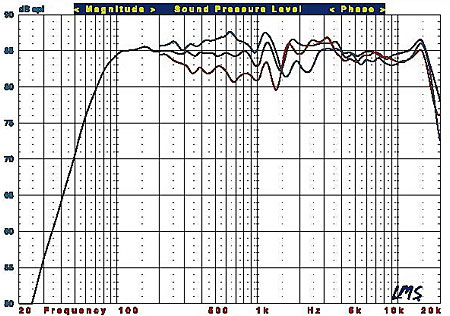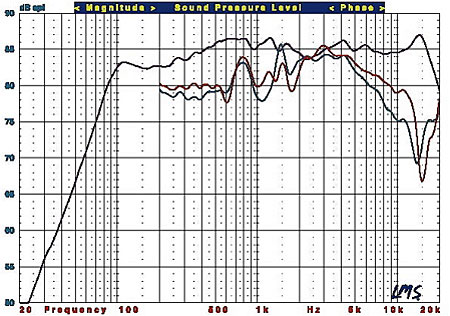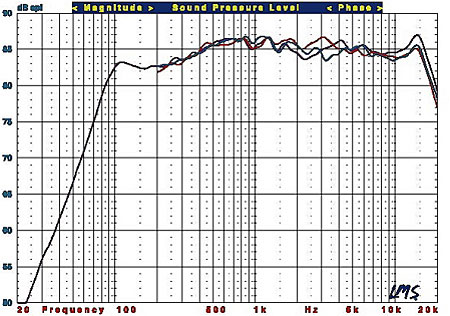Infinity Cascade Speaker System Technology and Measurements
As noted in the review, the diaphragms used in the bass/midrange and high frequency drivers in the Cascade speakers use Infinity's long-established CMMD (Ceramic Metal Matrix Diaphragm) technology. But the most interesting aspect of the speakers is the overall design and configuration of that new rectangular bass/midrange driver.
The diaphragm of this drive unit is ribbed to reduce cone breakup. It's driven by two rectangular voice coils with rounded ends, which, according to Infinity, allows it to function as an ideal piston. Neodymium magnets are used to keep the structure compact. Neodymium is also inherently shielded magnetically, though magnetic shielding is less important now than in the past because digital displays (LCD, plasma, LCoS, and DLP) are immune to magnetic fields.
Infinity argues that the large voice coils allow this bass/midrange driver to dissipate heat more effectively, resulting in improved transient response and decreased thermal compression. It might be argued, however, that this is offset, to a degree, by the greater mass of a large voice coil. It should also be noted that the back of the driver (based on the early unit I saw on an Infinity plant visit in 2005) is a cast aluminum frame that holds the magnets in place. This backplate is perforated to relieve the backpressure on the driver and allow it to "see" the inside of the speaker enclosure, which is important to achieve proper bass tuning of the system. But I wondered at the time whether the perforations were sufficient to avoid cavity resonances between the driver and its backplate, particularly at high sound pressure levels (the rear of the diaphragm on a conventional mid/bass driver is much more open to the interior of the cabinet). Could such resonances be the cause of the less than pristine midrange JB observed? It's a fact that many manufacturers (Vandersteen Audio, for example) have taken great care to minimize the structure behind their midrange drivers to eliminate any such effects.
Do you want to know more? There's additional technical information available about the Cascades in Infinity's product brochure, downloadable from the company's website.
Form follows function is something of an engineering touchstone, so how effective is the engineering behind the Infinity Cascades, a design in which it's clear from the product description that form was the overriding design goal? To be fair, that goal is increasingly important in a market in which large, bulky speakers sell mainly to passionate audiophiles.
The measurements shown here were made with the grilles removed. The grilles had less of a negative impact on the speakers' responses than with most speakers we have measured, though they did have a small effect on the result.
The impedance of the Cascade Model Nine dropped to a minimum of 4.68Ω at 1kHz and 4.84Ω at 241Hz. I would conservatively rate the nominal impedance at slightly lower than the specified 8Ω, but 8Ω is a reasonable value. The impedance phase angle also remains benign across the full audible range. The Cascade Model Nine should be an easy load to drive. But its sensitivity of approximately 85dB/2.83V/meter demands a potent amplifier if you intend to drive it to high levels. No single-ended triodes here, please!
The horizontal front response of the Model Nine is shown in Fig.1 (violet). This is the pseudo-anechoic response averaged over a 30° forward horizontal angle, taken at tweeter height, combined with the nearfield response of the woofers.

Fig.1: Infinity Cascade Model Nine, pseudo-anechoic response at 45° (red) and 60° (blue) to the left or right of the tweeter axis
The Model Nine's averaged front horizontal response is surprisingly smooth. I say surprisingly not because I don't expect this from Infinity (quite the contrary, in fact), but because of Joel's issues with the midrange (a bit muddled) and highs (a little soft). I can offer two possible explanations for the problems he noted in the midrange. The first is the response in the octave from 800Hz to about 1.6kHz. While the ripples here appear to be fairly innocuous, they do fall in the heart of the audible spectrum and just an octave or so below the point where human hearing is most sensitive. The other is the fact that frequency response measurements are always taken at low output. The cavity behind the bass/midrange driver, a characteristic of its design (as noted above), might cause problems at higher sound levels as pressure builds up in that cavity faster than it can dissipate.
As to Joel's issue with the highs, the wide off-axis response does fall off a bit faster than normal, but otherwise the tweeter turned produced a fine set of measurements.
The Model Nine's vertical response characteristics, shown in Fig.2, suggest that the best listening axis will not be particularly critical, though on or slightly below the tweeter axis is best.

Fig.2:, Infinity Cascade Model Nine pseudo-anechoic response at 15° above (red) and 15° below (blue) the tweeter axis
At the bottom end, the Model Nine has an effective lower limit of 56.5Hz (-10dB relative to the output at 100Hz). This speaker (and the Model Three C as well) has clearly been designed for use with a subwoofer.
The Cascade Model Three C center channel speaker's impedance dropped to a minimum value of 4.41Ω at 1.1kHz and, like its Model Nine sibling, can be fairly rated at 8 Ω with a benign phase angle. The Three C's sensitivity also measures approximately 85dB/2.83V/m. It should be an easy load to drive, though as with the Model Nine I'd recommend a relatively husky amp.
The measured front horizontal response of the Model Three C, taken on the tweeter axis and averaged in the same manner as described for the Model Nine, is shown in Figs.3aand 3b (violet curves). The effective bass extension is approximately 65Hz (-10dB relative to the output at 110Hz). The response is slightly lean through the mid and upper bass, which may have been deliberate to compensate for the midbass loading that occurs when a center channel speaker is placed atop a big-screen television.

Fig.3a: Infinity Cascade Model Three C, pseudo-anechoic response at 45° (red) and 60° (blue) to the left of the tweeter axis

Fig.3b: Infinity Cascade Model Three C, pseudo-anechoic response at 45° (red) and 60° (blue) to the right of the tweeter axis
Note also that while the on-axis averaged response of the Model Three C is very smooth (smoother through the midrange, in fact, than the Model Nine), the wide off-axis response displays the severe suckouts and erratic response that we see in virtually all horizontally arranged woofer-tweeter-woofer center channels. Note too that the off axis results in Fig.3a (off axis to the left) and Fig.3b (off axis to the right) look different. This suggests that the crossover to each bass/midrange driver has been tailored in an attempt to minimize the usual off-axis interference effects that cause these response dips. If so, it doesn't work, but then we've never measured a center channel speaker in which it does.
The vertical response measurements for the Model Three C in Fig.4 indicate that the vertical height of the ear relative to the speaker in this case is non-critical within the range measured.

Fig.4: Infinity Cascade Model Nine, pseudo-anechoic response at 15° above (red) and 15° below (blue) the tweeter axis
This is a respectable set of measurements. The on-axis response is smooth. The Model Three C's response appears well suited to use on top of a television, above typical ear height. The bass response of both the Model Nine and the Model Three C are tailored to blend well with a subwoofer. And the impedance of both designs is far more benign than with most speakers we have measured. The results are marred only by the severe response irregularities you'll experience from the Model Three C at wide off-axis listening positions. Though undesirable, this result is typical of horizontally arranged woofer-tweeter-woofer designs.
Violet (all figures): pseudo-anechoic response on the tweeter axis, averaged across a 30° horizontal window, combined with near-field responses of the woofers
- Log in or register to post comments




































































